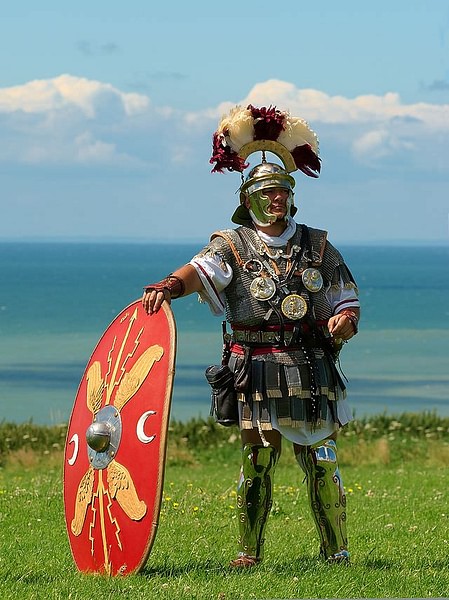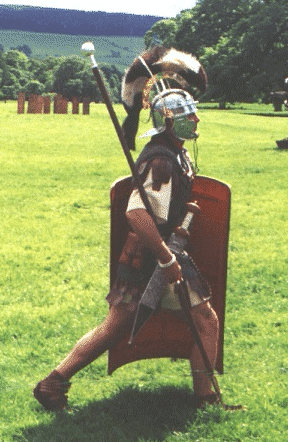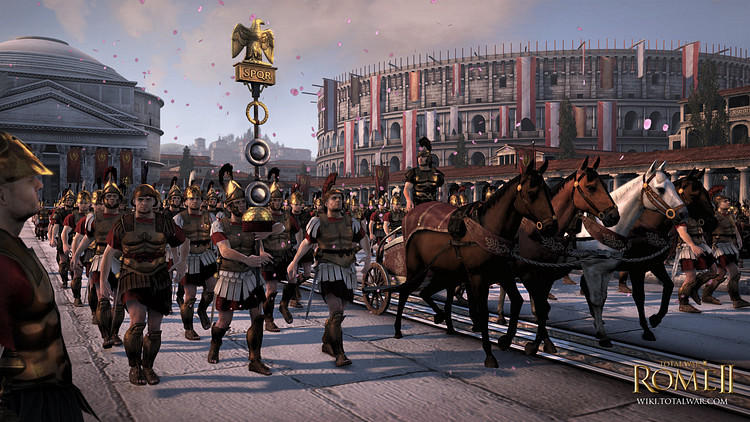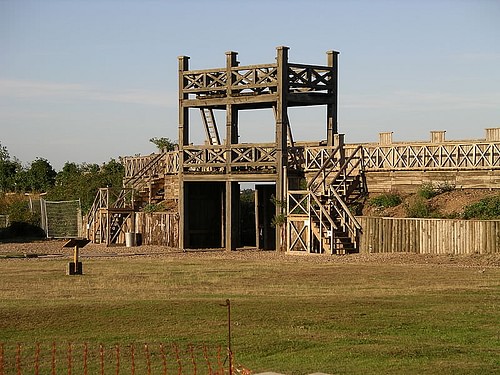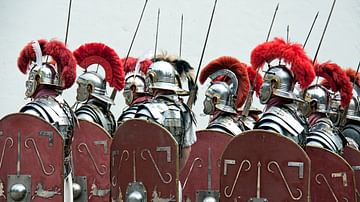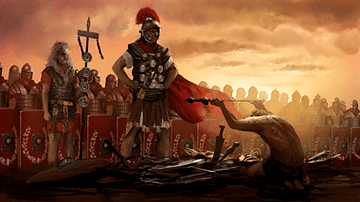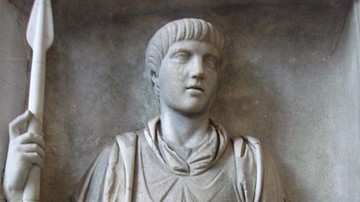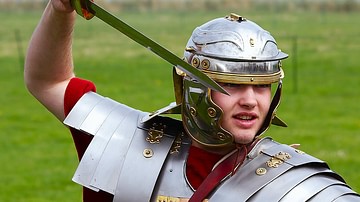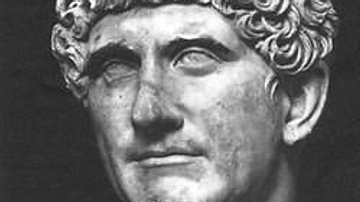With the appearance of the legionary, the Roman army was able to maintain a vast empire that totally embraced the Mediterranean Sea. Although the success of the army rested on the backs of the foot-soldiers and cavalry, there were others on the field and in camp who enabled them to prevail. Besides the famed centurion who stood at the front of his cohort and led his legionaries into battle, there was a command hierarchy of military tribunes, a camp prefect, and a legate. Alongside the centurion in the thick of battle were the principales: optio, signifier, aquilifer, and tesserarius. There were others, some with specialized skills, who were as essential but remained in camp. These were the immunes and beneficiari: laborers, clerks, surveyors, architects, engineers, and orderlies. The legionaries could not have conquered and maintained an empire without this capable support; together they made the Roman army a feared adversary for over eight centuries.
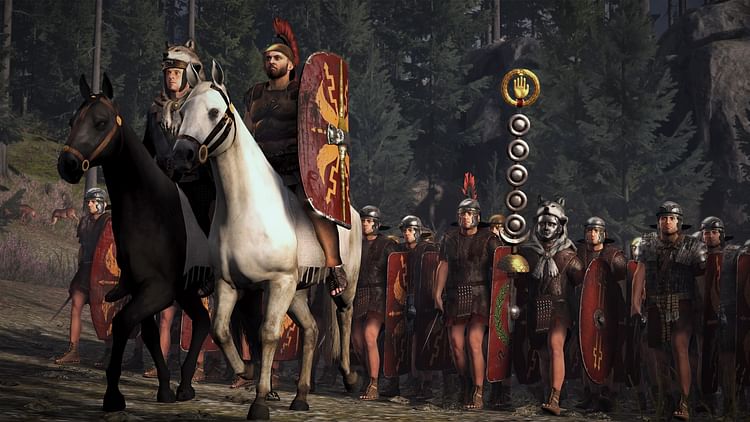
An Evermore Professional Army
Originally, the Roman army consisted of a citizen-based militia recruited from the propertied citizenry who only served for the duration of the war. There was a direct link between citizenship, property and the military. During the consulship of Gaius Marius (l. c. 157-86 BCE), the militia reinvented itself and became a professional army. The distinctions between age and experience that had existed before were abolished. Constant war had severely depleted the military. Realizing a need existed, Marius saw an untapped resource and changed the requirements for enlistment, recruiting from the poorer and unpropertied citizens of Rome. No longer did a soldier have to provide his equipment. The government provided all essentials: weapons, armor, and even clothing. With these changes, service in the army became extremely popular among the poor. It provided food, clothing, medical care, and a secure wage. The re-born legionary became better trained, better disciplined and therefore more flexible and effective.
Changes would continue throughout the imperial period. Prior to the time of Emperor Augustus (27 BCE - 14 CE), the Roman army was constantly on the march. As the borders of the empire expanded across Europe and into the Middle East, permanent fortresses began to appear to help stabilize the frontier. Augustus reduced the number of legions from 60 to 28. Most of these were stationed in the troubled provinces and along the borders. In the end, Rome had a standing army of 150,000 legionaries and 180,000 auxiliary infantry and cavalry. Although the number of legions was reduced, there still remained a need for loyal legionaries; however, the long examination and training process did not change. First, all recruits had to have their legal status checked to prevent slaves from joining the army. Besides his legal status, the individual’s age, fitness, education, and previous occupation were considered. If all standards were met during this probationary period, the recruit would enter the next step, receiving his signaculum: a piece of metal worn around the neck containing personal information about the soldier - similar to today’s army 'dog tags'. Upon his arrival at his assigned camp, he would undergo rigorous training before officially becoming a legionary.
The Centurion
Training was supervised by a specialized officer, usually the optio. Training included close-order drills, mock battles and one-on-one combat. Weapons-training was accomplished by using wicker shields and wooden swords. However, one of the first things the future legionary quickly learned was that discipline was harsh. A legionary had to obey orders without hesitation and, if not, he had to answer to the centurion or centurio. Aside from his other duties, the centurion was in charge of discipline, carrying with him the vitis or vine cane. With this, he could thrash a legionary for even a minor infraction. Supposedly, rigorous training, obedience, and harsh discipline made for an intimidating soldier.
Julius Caesar considered the centurion to be the backbone of the army, but the road to becoming a centurion came from many different directions. Normally, a centurion rose through the ranks. Some were former members of the imperial Praetorian Guard while others were members of the equestrian class, receiving commissions from the emperor. In battle, the centurion could be recognized by his silver armor, metal greaves, and transverse crested helmet. Also, unlike the legionnaires under his command, he wore his sword (gladius) on the left and dagger (pugio) on the right. In battle formation, he stood on the left of the first rank. In the camp barracks, he had his own special quarters with a separate latrine.
To become a centurion, an individual first of all, and most importantly, had to be literate, enabling him to understand orders (always given in Latin) and relaying them to the legionaries. Although a middle-ranking officer, he was often given other positions of great responsibility. He might be used as a training officer or on detached duty, serving as an administrator in one of the provinces. Often, he would serve in as many as 12 different legions during his 46-year career. Although frowned upon by more than one emperor, he might supplement his income by charging a small fee for granting a legionary a furlough during the quiet winter months. Upon his retirement, besides receiving his retirement pay, a centurion might become a lector for a Roman magistrate or command the Praetorian Guard.
With the assistance of the principales, the centurion commanded a century of 80 men - six centuries equaled a cohort of 480 men. Each century was broken down into ten squads of eight men known as a contubernium. These eight legionnaires developed a close bond, sharing a barracks room in the camp. They would fight together, eat together, and in some cases, die together. There were, in total, 59 centurions in a legion composed of ten cohorts. With the exception of the first cohort which had double the number of legionnaires and five centurions, the remaining nine cohorts had 54 centurions or six per cohort. Each of these six centurions had a specific title: in descending order they were the pilus prior, princeps prior, hastatus prior, pilus posterior, princeps posterior and hastatus posterior.
The centurions in the first cohort were the most important in the entire legion, known collectively as the primi ordines or men of first rank. It was led by the highest-ranking and most senior centurion of the entire legion: the primus pilus or first spear. He would often go on to become a camp prefect. Traditionally, he had to be at least 50 years old and usually served only a term of one year. Aside from becoming camp prefect, he might be elevated to the equestrian class or become a provincial governor. Below him in the first cohort were the remaining four centurions: in descending order they were the princeps prior, princeps posterior, hastatus prior, and hastatus posterior. The terms princeps and hastatus are titles reminiscent of the old maniples.
The Principales
Working alongside the centurion in camp and on the battlefield was a number of higher-ranking legionaries known as the principales. These legionaries often received one-and-half times to twice normal pay. Two of the principales served as staff adjuncts, one of them being the cornicularius while the other was the optio. Aside from his responsibilities as a training officer, it was the duty of the optio to stand with his staff of office, the hastile, to the extreme right in the rear of the century to keep order and prevent desertions. If the centurion were absent, the optio would take his place, and if a vacancy occurred for a new centurion, the optio would be promoted to fill it. However, if one chose a different route, he could become a tesserarius. He was then responsible for obtaining the passwords (written on a wax tablet or tessera), keeping them secure, and relaying them to the sentries. In battle, he stood to the left in the rear of the century.
Since each legion had its own standard, there were positions of great honor connected to the various flags and banners. Among them were the vexillarius or bearer of the cavalry standard (the vexillum), the signifier or bearer of the infantry standard (signum), the imaginifer or bearer of the emperor’s image, and, most importantly, the aquilifer, bearer of the golden eagle standard (aquilia). Associated with these men were the antesignani, foot soldiers situated before the standard, and the postsignani who came afterwards. One unique standard often used in parades was the signum draconis or draco carried by the draconarius. It was a bronze dragon’s head attached to a multi-colored tube of dyed cloth that would act like a wind-sock and howl when the cavalryman was moving quickly. It became commonly used by all Roman mounted units.
The need for individuals to assist the centurion on and off the battlefield provided opportunities if one had the essential motivation, education, and skills. One could choose to join the artillery, become a ballistari, and operate the siege machines. Another position, subordinate to the centurion, was the decurion, a junior officer who often commanded an auxiliary unit. The camps and fortresses also had their share of essential personnel who were often exempt from field duties. There were the beneficiari, often veterans who served as orderlies and clerks (libarius). Those individuals with specialized skills - engineers, carpenters, instructors, and medical staff - were called immunes and received additional pay for their labors. A camp or fortress also needed doctors, architects, ministers, and vets. There were even trumpeters and buglers who served as signalers in battle: the tubicines, cornicines, and buccinators. However, a truly ambitious legionary could strive to become a centurion even though it might take 12 to 15 years or more. Luckily, the prohibition against marriage did apply to centurions and other senior officers.
The Legate
The official hierarchy of a legion rested on three individuals. First was the legate (legatus legionus) followed by the broad-striped tribune (tribunus laticlavius), and lastly, the camp prefect (praefectus castrorum). Appointed by the emperor, the legate was not a professional soldier. He was usually in his early thirties and a member of the senatorial order, coming from Rome’s social and political elite. The legate was the legion commander and during the early imperial period he only served two years in the position; it would later be extended to four. In camp, his residence, the praetorium, reflected his status as a Roman senator with a garden, servant’s quarters, and accommodations for his family. On the battlefield, he would wear a richly, decorated helmet, body armor, a scarlet cloak or paludamentum, and a scarlet waistband or cincticulus. Like other imperial senior officers he was entitled to have fasces and lectors: in his case five fasces and five lectors. When he was absent from the fortress, his duties fell to the camp prefect.
The Tribune
The remaining two senior officers in the legion were the broad-striped tribune and camp prefect. The broad-striped tribune or the tribunus laticlavius was second in the hierarchy and on the road to the Senate. It is important not to confuse the military tribune with the tribune of the plebs. Each imperial legion had six tribunes but only one wore a broad purple stripe on his toga and tunic while the other five or augusticlavii wore a thin purple stripe. A young Roman member of the equestrian class often saw the position of tribune as a career stepping stone, but it was an undertaking that might take as long as nine years to achieve. Although it was not always a guarantee, this senatorial pursuit was often achieved by a broad-stripe tribune only after serving with the legion for three to six years. The thin-striped tribune had no authority or command powers and was limited to staff duties, sitting on court-martials and watch-command duties. To become a broad-stripe tribune am individual had to serve as the prefect or commander of both an auxiliary infantry and an auxiliary cavalry. In battle and serving as a commander of a unit, the broad-striped tribune could be recognized by his richly decorated helmet, molded armor, and white cloak, wearing his sword on his left hip. He, too, would have a house or domus that reflected his elite Roman status; however, he received no fasces or lectors.
The Camp Prefect
After the tribune, the third in command was the camp prefect or praefectus castrorum. A former primus pilus he would serve as commander of a legion detachment and, in the absence of the legate, be quartermaster in charge of a camp’s infrastructure: its construction, the barracks, camp facilities, maintenance of weapons, medical care, meals, water supply, and the manufacturing and storage of construction materials. The position was abolished in the 4th century CE.
The Roman legion and the legionnaires have become things of legend, copied by armies throughout the centuries. The legionary has repeatedly been acclaimed for his valor and stamina in battle. Standing next to him in battle was the centurion - leader on and off the field. However, while these men were celebrated and emulated, there was a host of individuals in camp and alongside the legionaries in battle that are somewhat forgotten but who were still vital to the success of the Roman military. These were the immunes, the beneficiari, and principales. All of these men aided the Romans in conquering an empire that embraced the Mediterranean.
